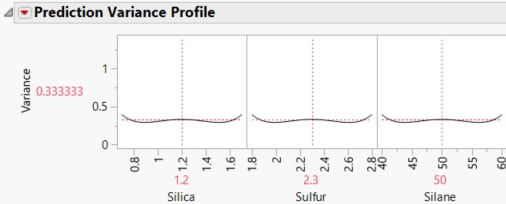Prediction Variance Profile
In the Evaluate Design report, the Prediction Variance Profile helps you to understand where in the design space your predictions have more or less variability. The Prediction Variance Profile plots the relative variance of prediction as a function of each factor at fixed values of the other factors. See Relative Prediction Variance.
Low prediction variance throughout the design space is desired. Generally, the error variance drops as the sample size increases. When comparing designs, the design with the lower average prediction variance is preferred.
Select the Maximize Variance option from the Prediction Variance Profile red triangle menu to identify the design setting with maximum variance. The value of the maximum variance in the Prediction Variance Profile is the worst (least desirable from a design point of view) value of the relative prediction variance. The maximum variance can occur at more than one combination of factor settings. To evaluate the prediction variance using a surface, see Prediction Variance Surface.
Figure 16.9 Prediction Variance Profiler
Relative Prediction Variance
For given settings of the factors, the prediction variance is the product of the error variance and a quantity that depends on the design and the factor settings. Before you run your experiment, the error variance is unknown, so the prediction variance is also unknown. However, the ratio of the prediction variance to the error variance is not a function of the error variance. This ratio, called the relative prediction variance, depends only on the design and the factor settings. Consequently, the relative variance of prediction can be calculated before acquiring the data. See “Relative Prediction Variance”.
After you run your experiment and fit a least squares model, you can estimate the error variance using the mean squared error (MSE) of the model fit. You can estimate the actual variance of prediction at any setting by multiplying the relative variance of prediction at that setting.
